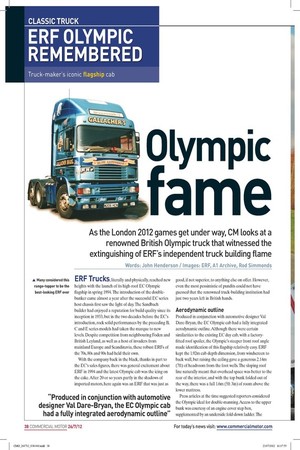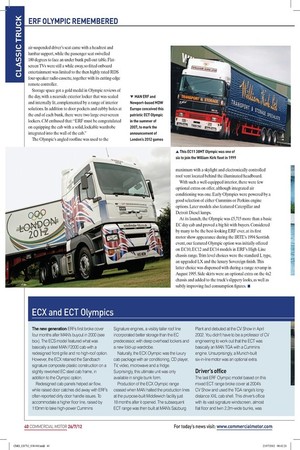Olympic
Page 28

Page 30

Page 31

If you've noticed an error in this article please click here to report it so we can fix it.
As the London 2012 games get under way, CM looks at a renowned British Olympic truck that witnessed the extinguishing of ERF’s independent truck building flame
Words: John Henderson / Images: ERF, A1 Archive, Rod Simmonds ERF Trucks, literally and physically, reached new heights with the launch of its high-roof EC Olympic lagship in spring 1994. The introduction of the doublebunker came almost a year after the successful EC series host chassis irst saw the light of day. The Sandbach builder had enjoyed a reputation for build quality since its inception in 1933, but in the two decades before the EC’s introduction, rock solid performances by the preceding B, C and E series models had taken the marque to new levels. Despite competition from neighbouring Foden and British Leyland, as well as a host of invaders from mainland Europe and Scandinavia, these robust ERFs of the 70s, 80s and 90s had held their own.
With the company back in the black, thanks in part to the EC’s sales igures, there was general excitement about ERF in 1994 and the latest Olympic cab was the icing on the cake. After 20 or so years partly in the shadows of imported motors, here again was an ERF that was just as good, if not superior, to anything else on offer. However, even the most pessimistic of pundits could not have guessed that the renowned truck-building institution had just two years left in British hands.
Aerodynamic outline
Produced in conjunction with automotive designer Val Dare-Bryan, the EC Olympic cab had a fully integrated aerodynamic outline. Although there were certain similarities to the existing EC day cab, with a factoryitted roof spoiler, the Olympic’s steeper front roof angle made identiication of this lagship relatively easy. ERF kept the 1.92m cab depth dimension, from windscreen to back wall, but raising the ceiling gave a generous 2.14m (7ft) of headroom from the foot wells. The sloping roof line naturally meant that overhead space was better to the rear of the interior, and with the top bunk folded out of the way, there was a full 1.6m (5ft 3in) of room above the lower mattress.
Press articles at the time suggested reporters considered the Olympic ideal for double-manning. Access to the upper bunk was courtesy of an engine cover step box, supplemented by an underside fold-down ladder. The air-suspended driver’s seat came with a headrest and lumbar support, while the passenger seat swivelled 180 degrees to face an under bunk pull-out table. Flatscreen TVs were still a while away, so itted onboard entertainment was limited to the then highly rated RDS four-speaker radio cassette, together with its cutting-edge remote controller.
Storage space got a gold medal in Olympic reviews of the day, with a nearside exterior locker that was sealed and internally lit, complemented by a range of interior solutions. In addition to door pockets and cubby holes at the end of each bunk, there were two large over-screen lockers. CM enthused that: “ERF must be congratulated on equipping the cab with a solid, lockable wardrobe integrated into the wall of the cab.” The Olympic’s angled rooline was used to the maximum with a skylight and electronically controlled roof vent located behind the illuminated headboard.
With such a well-equipped interior, there were few optional extras on offer, although integrated air conditioning was one. Early Olympics were powered by a good selection of either Cummins or Perkins engine options. Later models also featured Caterpillar and Detroit Diesel lumps.
At its launch, the Olympic was £5,715 more than a basic EC day cab and proved a big hit with buyers. Considered by many to be the best-looking ERF ever, at its irst motor show appearance during the IRTE’s 1994 Scottish event, our featured Olympic option was initially offered on EC10, EC12 and EC14 models in ERF’s High-Line chassis range. Trim level choices were the standard L type, an upgraded LX and the luxury Sovereign inish. This latter choice was dispensed with during a range revamp in August 1995. Side skirts were an optional extra on the 4x2 chassis and added to the truck’s slippery looks, as well as subtly improving fuel consumption igures. n
End of an era
By early 1996 ERF was the last independent British truck-maker left standing, but that era ended when Western Star Trucks Holdings bought the Sandbach builder later that year for a reported £27.4m.
▲ ECX range was the last ERF heavy truck built in Britain
Many observers were surprised by this move, because at the time ERF’s model line-up looked the strongest since its inception. Production of the highly rated EC range and its Olympic flagship continued and sales remained strong across global markets.
Just four years later, increased commercial pressure in the US saw Western Star dispose of ERF to MAN for £110m. Opinion on the deal was divided, with opposing factions calling it either a new beginning or a death knell.
The former camp was proved correct in August 2000 when a £28m production plant was built at nearby Middlewich. However, the pessimists had the final word when truck-making ceased there just two years later. MAN announced the end of the ERF brand in 2007.
ECX and ECT Olympics
The new generation ERFs first broke cover four months after MAN’s buyout in 2000 (see box). The ECS model featured what was basically a steel MAN F2000 cab with a redesigned front grille and no high-roof option. However, the ECX retained the Sandbach signature composite plastic construction on a slightly reworked EC steel cab frame, in addition to the Olympic option.
Redesigned cab panels helped air flow, while raised door catches did away with ERF’s often-reported dirty door handle issues. To accommodate a higher floor line, raised by 110mm to take high-power Cummins Signature engines, a visibly taller roof line incorporated better storage than the EC predecessor, with deep overhead lockers and a new fold-up wardrobe.
Naturally, the ECX Olympic was the luxury cab package with air conditioning, CD player, TV, video, microwave and a fridge. Surprisingly, this ultimate unit was only available in single bunk form.
Production of the ECX Olympic range ceased when MAN halted the production lines at the purpose-built Middlewich facility just 18 months after it opened. The subsequent ECT range was then built at MAN’s Salzburg Plant and debuted at the CV Show in April 2002. You didn’t have to be a professor of CV engineering to work out that the ECT was basically an MAN TGA with a Cummins engine. Unsurprisingly, a Munich-built six-in-line motor was an optional extra.
Driver’s office
The last ERF Olympic model based on this mixed ECT range broke cover at 2004’s CV Show and used the TGA range’s longdistance XXL cab shell. This driver’s office with its vast signature windscreen, almost flat floor and twin 2.2m-wide bunks, was an attractive place to work and live.
MAN ERF product manager Steve Jones enthused that he had envisaged initial orders of between 350 and 400 units for the ECT Olympic’s first year in build, but within two months of the Birmingham event that figure had risen. Most buyers opted for the 10.8-litre Cummins 420PS engine against the bigger MAN 480PS common-rail power plant. In addition to the interior’s quality fit and finish, ECT drivers also had the left foot luxury of Comfortshift, which used a gearstick-mounted thumb button for clutch activation, once on the move.
Despite the maker’s popularity claims, the ECT Olympic was probably the lowest seller of the three successive truck types to carry this exclusive badge and to no one’s great surprise, MAN decided to cease supply of ERF-badged trucks in July 2007. This year, in a strange twist of fate, MAN wished to christen its 2012 TGX flagship the Olympic, but legal objections from London 2012 organisers saw the truck designated the Corinthian5 instead.









































